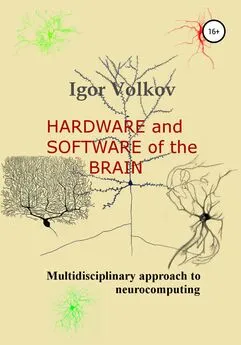Igor Volkov - Hardware and software of the brain
- Название:Hardware and software of the brain
- Автор:
- Жанр:
- Издательство:неизвестно
- Год:2022
- ISBN:нет данных
- Рейтинг:
- Избранное:Добавить в избранное
-
Отзывы:
-
Ваша оценка:
Igor Volkov - Hardware and software of the brain краткое содержание
Hardware and software of the brain - читать онлайн бесплатно ознакомительный отрывок
Интервал:
Закладка:
The main approach to creativity remains ancient trials-and-errors method. For computers, more orderly variants such as full scan of possible solutions are used. In any case, the processor should prompt some actions, then assess their results. That's exactly what the limbic system does. Looks like the amygdala is a block of system-level memory similar to the basal ganglia. Only they keep elementary programs for sensorimotor coordination while the amygdala keeps genetically predetermined states of the brain itself such as fear or aggression. Human emotions correspond to processor instructions of computers, only the brain doesn't use the Von Neumann architecture. It uses a finite-state machine which has elementary states rather than actions. This approach may be very powerful. It is well known that the brain parts tend to have connections according to the principle of all-to-all. Not all of them are used at once. Instead, only a fraction is employed when necessary. This means that you can dynamically create different working machines for different circumstances.
On the other hand, the hippocampus has all the necessary means to assess the results. It receives input from major sensory channels and can generate sharp pulses of activation at the output. Again, this works differently. When you write a control program, you would create a variable to measure the assessment. Say, in the range [-1,1]. The program will input data, process it, set that variable, then use it for decision making. Looks like the brain has not such a separate variable. Instead, associative memory immediately links an input situation to the appropriate emotional reaction such as attraction or aversion. That's why negative emotions are harmful. You get tensed and if this tension has no exit, you must contain it. That leads to double tension and quick tiredness.
Other parts of functional architecture
If the neocortex is the associative memory of the brain and the limbic system – its processor, the next step would be to describe Input/Output system. In contrast to PC, human memory is anatomically partitioned and different parts are assigned for different purposes. Comparison of human and computer I/O systems may be as lengthy as the preceding comparison of central processing, but now we will just mention that they are very different as well and concentrate on the first. In particular, I/O system of PC was very asymmetric. These computers had quickly got a graphical display with a complicated controller and a video card, but the main input remained a keyboard and a mouse. When decent video input became available, PC itself already lost its market share. Output subsystem was obviously better developed here and the term "programming" reflects this. It refers more to generating output actions and pays less attention to analysis of input data.
In humans, the main input comes from vision and the main output goes to muscles via the motor system. Both are approximately equally developed. They have cortical and subcortical representation of comparable complexity. The human sensory system has several different receptors (vision, hearing, etc.) with separate sensory channels. At the top, all of them converge in the TPO (Temporalis-Parietalis-Occipitalis) region of the neocortex which resides between cortical representations of different sensory modalities. The TPO zone obviously syntheses an abstract picture of the world and is also related to human consciousness.
Конец ознакомительного фрагмента.
Текст предоставлен ООО «ЛитРес».
Прочитайте эту книгу целиком, купив полную легальную версию на ЛитРес.
Безопасно оплатить книгу можно банковской картой Visa, MasterCard, Maestro, со счета мобильного телефона, с платежного терминала, в салоне МТС или Связной, через PayPal, WebMoney, Яндекс.Деньги, QIWI Кошелек, бонусными картами или другим удобным Вам способом.
Интервал:
Закладка:










